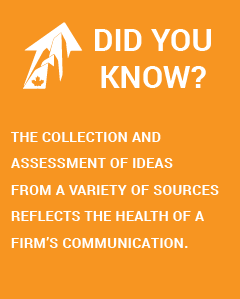

Innovation practice:
Innovative ideas and suggestions from employees, suppliers and other sources are collected and evaluated objectively during the project.
The most recent comprehensive survey of innovation in the Canadian construction industry was published by Statistics Canada in 2001 (Andersen and Schaan). The survey identified suppliers and subcontractors as, by far, the primary source of new ideas for the industry, and also looked at trade journals and magazines, universities and research organizations as other sources outside the organization.
It has been well-established that organizations need to be active in collecting and assessing ideas from outside, as well as inside the project team (e.g., from employees, suppliers, and contractors, during project execution). Good communication of ideas fosters an innovative environment and leads to success (Aiken and Hage, 1971). For example, we have a culture of toolbox talks that focused on safety, why not do the same for good ideas?
References:
- Aiken, M., and Hage, J. (1971). “The organic organization and innovation.” Sociology, 5(1), 63–82.
- Anderson, F. and Schaan, S. (2001). Innovation, Advanced Technologies and Practices in the Construction and Related Industries: National Estimates, Statistics Canada, 88F0006XIB01004.
Next installment: Why are we surprised when projects exceed their schedule targets?
Previous installment: You cannot improve what you do not measure

ABOUT THE PERFORMANCE BENCHMARKING TOOL
The free Performance Benchmarking Self-Assessment Tool is designed to assist construction and maintenance employers in measuring their organization in relation to a specific set of recognized best practices. In addition, you will be able to compare your organization’s efforts against other construction and maintenance employers. From the results of the self-assessment tool you will also be able to identify areas for continuous improvement.
The self-assessment tool is designed to be completed either individually by a member of your management team or in a collaborative setting. Consider bringing your leaders/managers together to work through the tool and take time to discuss the perspectives of each group member.
This initiative is supported by the National Research Council of Canada Industrial Research Assistance Program (NRC IRAP).

Productivity
